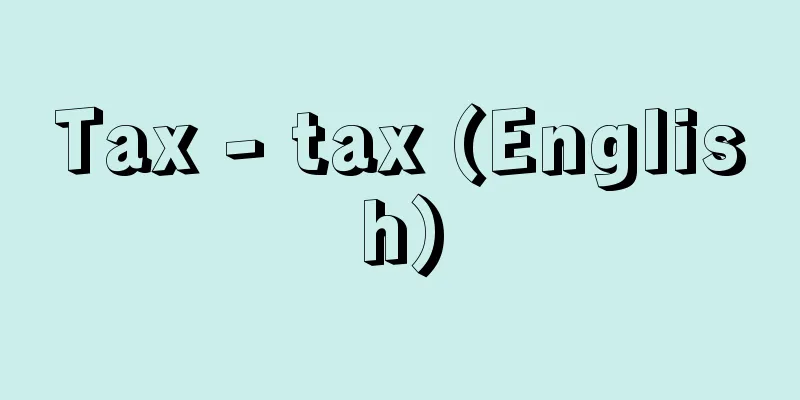Tax - tax (English)

The significance of taxesA tax is a payment of money or other form of property that is forcibly levied or collected by a state or local government based on its fiscal power without providing any direct compensation for the purpose of covering general expenses. It is also called a tax or a tax. The Organization for Economic Cooperation and Development (OECD) uses the term "tax" to refer to payments made to the general government (the government in the narrow sense consisting of the central government, local governments, and social security funds) without compulsory compensation. A tax is a payment without compensation in the sense that the government does not usually provide a benefit proportional to the payment. In the OECD tax classification, taxes are classified as taxes on income and profits (classification item 1000), taxes on wages (classification item 3000), taxes on property (classification item 4000), taxes on consumption (classification item 5000), and other taxes (classification item 6000). Social security contributions paid to the general government (classification item 2000) are also treated as taxes. The following theories have been put forward to explain why we must pay taxes: the public demand theory, advocated by the 17th century German Chancellor School, which states that the state and local public organizations collect the taxes they need to fulfill their duty of promoting public welfare; the exchange theory (benefit theory) advocated by the Classical School, which states that people pay taxes in return for the benefits they receive from the activities of the state and local public organizations; the insurance theory, which states that people entrust the safety of their lives and property to the state, and therefore must pay taxes to the state just as they pay insurance premiums to an insurer; and the obligation theory (sacrifice theory), which states that the state and local public organizations are institutions necessary for each person's life, and therefore members have an obligation to bear the funds necessary for their activities. Today's conventional view on the basis of taxation is close to the obligation theory, and is explained as follows: In countries with economic systems known as capitalist or free market economies, the private sector plays a leading role in supplying basic goods and services necessary for people's lives, and people bear the costs corresponding to the individual benefits of goods and services by paying individual prices. In other words, direct exchange is at the heart of economic activity, and if the value of a particular good or service is higher than the price that constitutes a burden, people will voluntarily purchase or consume that good or service even if they pay the price, so compulsory collection such as taxes is unnecessary. Goods and services exchanged voluntarily in the private sector are called private goods, and their characteristic is that the benefits obtained from those goods and services belong exclusively to the specific individuals who consume them. People can enjoy the benefits only if they bear the costs themselves, and the application of the exclusion principle, which excludes those who do not bear the costs from enjoying the benefits due to ownership, is guaranteed, so people will voluntarily bear the costs. However, some goods and services have a characteristic that makes it impossible to limit the benefits to certain people. This characteristic is called non-rivalry in consumption, and typical examples are national defense and lighthouses. In the case of these goods and services, it is technically impossible to limit the benefits to certain people who pay the toll, or even if it is technically possible, it is economically irrational to do so. For example, even if it is technically possible to set up checkpoints on city roads, as with toll roads, to exclude people who do not pay the toll, it is economically unreasonable to do so, considering the traffic hindrances, the construction costs of the checkpoints, and the personnel costs of toll collectors. Therefore, in the case of goods and services that have the characteristic of non-rivalry in consumption, it is technically and economically impossible to apply the exclusion principle to exclude people who do not pay the toll. However, if people can enjoy the benefits just as much as those who do not pay the toll, it is more rational to "free ride" on the benefits without paying the toll, and people will not voluntarily try to pay the toll. However, this does not mean that the supply of these goods and services is free of cost, and therefore it is necessary to raise funds in the form of compulsory taxes instead of voluntary contributions. This is why compulsory levies such as taxes are necessary even in a free market economy with a private sector based on free voluntary exchange. [Masatoshi Hayashi] Taxation PrinciplesDue to this nature of taxes, people try to avoid tax burdens as much as possible, but in order to raise necessary tax revenues, it is essential to impose and collect taxes in some form. Even if the tax revenue is the same, there are good and bad taxes. A good tax must meet certain conditions, and these conditions are called the principles of taxation. Adam Smith listed four principles: the principle of fairness, the principle of clarity, the principle of expediency, and the principle of least taxation. In the second half of the 19th century, Adolf Wagner proposed the following nine principles that encompass Smith's four principles: [1] Principles of Fiscal Policy (2) Principle of flexibility: Revenues must be flexible enough to be easily adjusted in response to changes in financial circumstances. [2] Principles of the National Economy (4) Principle of selection of tax type In light of the principles of national economy and fairness, an appropriate tax type must be selected, taking into consideration tax pass-through, so that the burden actually falls on those who should bear the tax. [3] Principle of Fairness (6) Principle of equality Taxes should be levied in proportion to each individual's ability to contribute. Because the ability to contribute increases progressively rather than proportionally to increases in income, progressive taxation is necessary. In other words, each person must make equal sacrifices as a natural duty for the maintenance and development of the nation. [4] Principles of Tax Administration (8) Principle of Convenience Choices must be made regarding the place of tax payment, the time of tax collection, the procedures for tax collection, etc., so that payment or collection of tax is convenient for taxpayers and tax collectors. (9) Principle of Minimum Taxation Costs Taxation costs necessary to obtain tax revenue should be kept as low as possible. Modern economists have simplified the principle of taxation even further, listing the principle of neutrality in addition to the principle of fairness mentioned above. The principle of neutrality states that since taxes have various distorting effects on economic activity, it is desirable for taxes to be as neutral as possible with respect to economic activity. A prominent feature of today's welfare states is the absolute and relative expansion of the public sector, and the inevitable increase in the tax burden rate that accompanies this, so there is growing concern about the distorting effects of taxes on economic activity. In formulating today's tax systems, the principles of fairness and neutrality are important criteria, and the policy challenge is to achieve the optimal balance between the two. From the perspective of tax law, tax legislation must first formally comply with the requirement of the tax law principle. Tax requirements (taxpayers, taxable objects, tax bases, tax rates, etc.) as well as procedures for collection and payment must be strictly and precisely defined in laws and ordinances enacted by the National Diet and local assemblies. Substantively, requirements such as the principle of equality based on ability to pay and the principle of exemption from tax on minimum living expenses must be met. [Masatoshi Hayashi] Tax shifting and impositionConsidering the nature of taxation, the principle of fairness is extremely important, but a difficult problem to face when establishing a tax system that aims for fairness in the burden is tax pass-through. Tax pass-through refers to the phenomenon in which the tax burden is shifted from taxpayers to others. There are two types of pass-through: forward pass-through, where the tax is passed on from upstream to downstream in the flow from production to consumption, and backward pass-through, where the tax is passed on in the opposite direction. In Japan, the consumption tax is passed on from the business, who is the taxpayer, to the consumer, who is the taxpayer. In general, indirect taxes are often passed on forward. Also, if a parent company is taxed and compensates by lowering the delivery price of its subcontractors, this is a backward pass-through. In this way, the tax burden finally falls on someone, which is called attribution. The issue of fairness must be discussed and judged based on this attribution, but the analysis of pass-through is not easy, and there is no consensus yet on the pass-through of corporate taxes, in particular. [Masatoshi Hayashi] Tax PolicyThe primary purpose of taxes is to raise funds for government expenses, but today they can also serve the secondary or intentional functions of redistributing income and wealth and stabilizing the economy. In developed capitalist countries since the 1960s, tax policy has often been implemented as part of fiscal policy. [Masatoshi Hayashi] Taxation and the redistribution of income and wealthAlthough it is difficult to clearly define the content of equality, there is no doubt that it is an important value in today's society. With regard to economic conditions, the idea of correcting excessive inequality through taxation is common. This includes setting a minimum tax level, applying progressive tax rates, adopting property and inheritance taxes, and heavy taxation on luxury goods. However, special tax measures such as exemptions or reductions on interest, dividends, and capital gains are often taken for the purpose of increasing savings, and the reality is that the tax system as a whole does not have much of a redistribution effect. [Masatoshi Hayashi] Taxation and economic stabilityIt is well known that if left unchecked, capitalist economies are subject to economic fluctuations, resulting in serious problems such as unemployment and inflation, but in today's capitalist economy, the government actively intervenes to pursue economic stability as a policy. Taxes absorb purchasing power or demand from the private sector, and in this respect too, they have a significant impact on the economy. The effect of the public sector on the economy is determined by the balance between public expenditures and taxes, but if we focus only on taxes, and all other conditions are equal, tax increases have a restraining effect on the economy by absorbing purchasing power from the private sector, while tax cuts during recessions create new purchasing power in the private sector and stimulate the economy. Today's progressive income tax, social security taxes such as unemployment insurance, and corporate taxes have the function of stabilizing the economy. In other words, when the economy is booming, income increases, but under a progressive tax system, tax revenue increases at a rate higher than the rate of increase in income. Social security taxes also transfer purchasing power from the private sector to the government in the form of insurance premiums when the employment rate is high and there are few unemployed people, but conversely, when the economy is in a slump and the number of unemployed increases, a transfer of purchasing power occurs from the government to the private sector in the form of insurance benefits. In addition, corporate profits are very sensitive to the economy, and while in good times they are largely absorbed by the government in the form of taxes, in bad times they need to pay very little tax. In this way, today's tax system has what are called built-in stabilizers, which have an effect of stabilizing the economy. [Masatoshi Hayashi] Tax ClassificationSince Adam Smith, various methods have been tried for classifying taxes. Adam Smith classified taxes into four types based on the source of tax, which is primary income: (1) taxes levied on rent, (2) profits, and (3) taxes levied on wages, and (4) taxes levied indiscriminately on rent, profits, and wages.He also listed inheritance tax, property transfer tax, new house tax, and stamp duty as special taxes that do not fall into any of the above categories. Adolf Wagner classified income or wealth into three different aspects: acquisition, ownership, and expenditure. (1) Taxation on Acquisitions (a) Taxes on professional acquisitions or direct taxes (poll taxes, class taxes, income taxes, profit taxes); (b) Taxes on specific acquisitions or legal acts (circulation taxes, stamp taxes, registration taxes); (c) Taxes on accidental acquisitions or appreciation (lottery taxes, profit taxes, inheritance taxes). [Masatoshi Hayashi] Current and temporary taxesThe distinction between ordinary taxes and extraordinary taxes lies in whether they are levied regularly and continuously from year to year, or whether they are levied temporarily for a limited period of time under an emergency. Historically, taxes originated as extraordinary taxes levied to meet war and other extraordinary needs, but in the current tax system, ordinary taxes are the rule, and when additional financial resources are needed temporarily, it is normal to rely on sources other than taxes, such as government bonds. The property tax, special war compensation tax, and special tax for non-war victims imposed in Japan after World War II were rather exceptional extraordinary taxes. [Masatoshi Hayashi] General taxes and special taxesThe distinction between general taxes (ordinary taxes) and earmarked taxes is made according to whether the tax is used for general expenses without a specified use, or whether it is used for specific expenses. Today, general taxes are the rule, and earmarked taxes are the exception rather than the rule. When earmarked taxes are high, they are used for purposes that generate a lot of revenue, even if the overall need for those purposes is not necessarily high. On the other hand, expenditures for purposes that are highly necessary will be restrained if the revenue is low, which hinders the optimal allocation of resources overall. Under the current Japanese system, the local road tax and the energy development promotion tax are earmarked taxes among national taxes. Among prefectural taxes, the automobile acquisition tax, light oil collection tax, and hunting tax, and among municipal taxes, the hot spring tax, business establishment tax, city planning tax, water use land benefit tax, common facility tax, and residential development tax are classified as earmarked taxes. [Masatoshi Hayashi] Personal and product taxesThe difference between personal taxes (taxes against persons) and property taxes (taxes against property) is that the former is a tax that takes into consideration the personal circumstances of the taxpayer and aims to tax each taxpayer according to their tax-paying capacity, while the latter is a tax that focuses on the taxable object objectively, without taking into account the personal circumstances of the taxpayer. In selecting the taxable object, the taxpayer's tax-paying capacity is generally and indirectly taken into account, but the relationship is not as direct as with personal taxes. A typical personal tax is income tax, while alcohol tax and tobacco tax are typical property taxes. [Masatoshi Hayashi] Direct and indirect taxesThere are various standards for distinguishing between direct and indirect taxes. According to the standard of whether or not the tax is passed on, a tax that is collected directly from the person who bears the tax is a direct tax, and a tax that is passed on to a person other than the taxpayer is an indirect tax. Although the standard is whether or not the tax is passed on, the fact and degree of the pass on cannot be determined univocally because it is influenced by the economic power relations of the parties involved. Therefore, there is also a classification based on whether or not the pass on is assumed as an intention of the legislator, rather than whether or not the pass on is assumed as an objective fact. In other words, a tax that the taxpayer will actually bear the burden of, according to the legislator's intention, is a direct tax, and a tax whose burden is passed on to a person other than the taxpayer is an indirect tax. According to the standard of tax administration techniques, a direct tax is a tax levied according to a tax ledger or taxpayer list, and an indirect tax is a tax levied according to a tax rate table. This classification based on this standard has been adopted for a long time in France. Another standard is the permanence of the taxable object, which is a classification method that is influential in Germany and Italy. According to this, direct taxes are those whose object is something of a permanent nature, such as something that exists, something that is possessed, or an occupation, while indirect taxes are those whose object is a specific, intermittent fact, such as something that is produced or an action. Another criterion is based on the economic nature of the taxable object, and there are three types of classification: (1) taxes on ownership are direct taxes and taxes on consumption are indirect taxes; (2) taxes on production are direct taxes and taxes on consumption are indirect taxes; and (3) taxes on acquisition are direct taxes and taxes on expenditure are indirect taxes. In addition, according to the classification based on the method of grasping the ability to bear, direct taxes are taxes levied on income or property, which directly represent the ability to bear, i.e., wealth, while indirect taxes are taxes levied on the circulation, transfer, consumption, etc. of goods, which indirectly represent or indirectly infer the existence of the ability to bear. The Organization for Economic Cooperation and Development (OECD) does not provide a definition of direct and indirect taxes, but direct taxes are taxes levied directly on income or wealth, and indirect taxes are taxes levied on expenditures. Therefore, in the OECD tax classification, taxes on income and profits (classification item 1000), social security contributions (classification item 2000), and payroll taxes (classification item 3000) are clearly classified as direct taxes, while taxes on goods and services (classification item 5000) are indirect taxes. Property taxes (classification item 4000) can be classified as either direct or indirect taxes depending on the interpretation, but the OECD classifies them as direct taxes. Based on this classification, the ratio of direct and indirect taxes for all OECD countries was 67:33 in 1975, 67:33 in 1995, and 68:32 in 2005, with the ratio of direct taxes increasing. However, the ratios of the combined amount of personal income tax and corporate income tax, which were traditional direct taxes, have fallen to 38%, 35%, and 35%, respectively, and among indirect taxes, the ratio of value-added tax has clearly risen to 14.5%, 17.7%, and 18.8%. In the case of Japan, the direct/indirect tax ratios based on the OECD classification for each fiscal year were 82.6:17.4, 84.0:16.0, and 80.3:19.7, respectively, and although they are declining due to the introduction of the consumption tax and the increase in its tax rate, they are still significantly higher than the OECD as a whole. [Masatoshi Hayashi] Property and income taxesThe distinction between property taxes (capital taxes) and income taxes is made based on two different criteria: whether the tax source is property (capital) or income, and whether the tax object is property (capital) or income. Taxes whose tax source is property (capital) are called real property taxes (capital taxes), and require the disposal or consumption of property (capital) in order to pay the tax. Taxes whose tax source is income and from which the tax is paid are called income taxes. On the other hand, there are taxes whose tax object is property (capital) but whose tax source is income. Current property taxes (capital taxes) levied annually at a low rate are property taxes (capital taxes) in the sense that their tax object is property (capital), but their tax source is income, and they do not require the disposal of property (capital) in order to pay the tax, and are paid from income. This type of tax is called nominal property taxes (capital taxes). Examples of real property taxes (capital taxes) include the German defense tax of 1913 and the temporary property taxes imposed and collected in Germany, Italy, Poland, Czechoslovakia, Austria, Hungary, Greece, and Russia after World War I to deal with the accumulation of national debt and the expansion of expenses. Temporary property taxes were also imposed in various countries during and after World War II, including Japan, where property taxes, special war compensation taxes, and special taxes for non-war victims were levied. These are examples of real property taxes. On the other hand, the wealth tax, which was introduced in 1950 (Showa 25) based on the Shoup recommendations and abolished in 1952, was a property tax that supplemented income taxes and was levied at a lower rate each year, and was a nominal property tax. The current fixed property tax is also a nominal property tax, since it is a tax paid from income, although the object of the tax is property (capital). If the inheritance tax is large, it may be impossible to pay it without disposing of assets, but if the amount is small it may be possible to pay it from income, so it is somewhere between the two. [Masatoshi Hayashi] Independent and additional taxesA tax that the national or local government can set its own tax base and tax rate independently of taxes imposed by other organizations is called an independent tax, while a tax that is imposed based on a tax imposed by another organization is called a surtax. In the broad sense, a surtax is a tax that is imposed based on the tax base of another tax or the amount of another tax, while in the narrow sense, a surtax is only a tax that is imposed based on the amount of the other tax. The tax that is the base on which a surtax is imposed is called a principal tax. Surtaxes are restricted by the principal tax, and a limited tax rate is often set. In Japan, various local surtaxes existed throughout the Meiji, Taisho, and Showa periods, but after the war, based on the Shoup recommendations, surtaxes were completely abolished and replaced with independent taxes in order to strengthen local autonomy. The advantages of the surcharge system are (1) that the taxation system is simple, and that it is possible to save on tax collection costs, (2) that it is easy to unify the tax system nationwide, and (3) that it allows other organizations to tax large tax bases that cannot be fully utilized by one organization. On the other hand, its disadvantages are: (1) that it is a system established for the needs of a specific organization (mainly the nation), and therefore it is difficult to levy taxes unique to other organizations that suit their special circumstances, (2) that tax system reforms made due to the circumstances of the organization that levied the surcharge automatically affect other organizations, and (3) that in cases where the surcharge system is not appropriate, its adverse effects are amplified. In Japan's current tax system, the amount of deductions is different, so it does not completely match the amount of income of the taxable subject of national income tax, and although there is a difference in that it is a tax on income in the previous year, the individual income portion of the local resident tax has the nature of a surcharge on national income tax. In addition, the corporate inhabitant tax is a surtax in the narrow sense, since the tax base is the amount of the national corporate tax, while the enterprise tax is levied on individuals and corporations based on income (profit) as the tax base, so it can be said to be a surtax in the broad sense of the word, similar to the national income tax and enterprise tax. With regard to the corporate enterprise tax, a size-based taxation system was created in the 2003 (Heisei 15) reform, targeting corporations with capital of over 100 million yen, and has been applied since the business year beginning on or after April 1, 2004, but it is designed so that one-quarter is a size-based tax and three-quarters is an income tax. [Masatoshi Hayashi] Flat tax/proportional tax/progressive tax/regressive tax/regressive taxThis classification corresponds to the type of tax rate. A flat tax is a tax that levies a flat amount per person or per material unit, ignoring factors such as tax-paying capacity. A poll tax levies the same amount of tax per person, and Japan's flat-rate local resident tax is an example of this. A proportional tax is a tax that applies the same tax rate regardless of the size of the tax base. A progressive tax is a tax in which a higher tax rate is applied as the tax base increases, and the ratio of the tax amount to the tax base increases, while a regressive tax is a tax in which this ratio decreases. A progressive tax is a tax in which the tax rate increases up to a certain tax base, but the same tax rate is applied to any tax base above that, and a progressive tax is also a type of progressive tax. [Masatoshi Hayashi] Taxes in major countriesEach country's tax system has developed in its own way, influenced by the national character, traditions, and economic circumstances of the country, but it was generally after World War I that countries began to adopt modern tax systems. At that time, income taxes became the core of the tax system. Typical examples were the United States and the United Kingdom, where income taxes came to occupy the most important position in tax revenue. France and Italy adopted a new type of circulation tax called a general transaction tax (turnover tax) along with income taxes, and these two became the main pillars of tax revenue. Germany focused on income taxes, but also introduced a general transaction tax. Thus, the tax systems of major countries can be broadly divided into the Anglo-American type, which focuses on income taxes, especially income taxes, and the continental type, which places emphasis on general transaction taxes and consumption taxes. After the Second World War, in 1954, France replaced its previous general transaction tax with a more rational value-added tax. In 1967, the European Community (EC)-style value-added tax was developed as a common tax for the EC, using this French value-added tax as a model. As a result, EC countries gradually shifted from general transaction taxes to value-added taxes, and the UK also introduced a value-added tax when it joined the EC, which it still has to this day. The EC was further strengthened in 1993 to form the EU (European Union). When comparing the national taxes of major countries, the characteristics of each country can be seen in the choice of tax items, the proportion of each tax item, and the ratio of direct and indirect taxes. As mentioned above, the United States and the United Kingdom have traditionally adopted tax systems centered on direct taxes such as income taxes, while continental European countries such as Germany, France, and Italy have focused on indirect taxes, but the proportion of direct taxes has been gradually increasing in recent years. Also, it is characteristic of EU countries that the proportion of value-added taxes among indirect taxes is large. The increase in the tax burden as a percentage of national income in major countries is a notable phenomenon seen in many countries as public expenditures expand and the public sector expands. After World War II, countries around the world competed to build welfare states, but the financial consequences were huge financial burdens, and despite unprecedented reliance on public bonds, tax burden rates have continued to rise since the war. Recently, each country has been trying to curb the expansion of the public sector. The tax burden rate is expressed as the amount of tax paid as a percentage of the total economic pie, which is represented by GDP, and there are large disparities between countries. The simple average for Organisation for Economic Co-operation and Development (OECD) countries was 29.5% in 1975, 34.9% in 1995, and 36.2% in 2005, and has been on an upward trend. Japan's tax burden rate has risen rapidly to 20.9%, 26.8%, and 27.4% in the corresponding years. In Sweden, which has a high tax burden rate, the rates are 41.6%, 48.1%, and 50.7%, nearly double Japan's. South Korea's tax burden rates are 15.1%, 19.4%, and 25.5%, respectively, and were previously significantly lower than Japan's, but have been on a significant upward trend in recent years. Looking at the index of the ratio of taxes to total tax revenues, OECD countries as a whole have fallen to 30%, 27%, and 25% compared to 1975, 1995, and 2005, personal income taxes have been declining at 30%, 27%, and 25%. Corporate income taxes are relatively stable at 8%, 8%, and 10%. Social security contributions have risen to 22%, 25%, and 26%. Property tax ratios are stable at 6%, 6%, and 6%. With the spread of value-added tax, the ratio of general consumption tax has risen to 15%, 18%, and 19%, while the ratio of individual consumption tax has fallen to 18%, 13%, and 11%. The proportion of Japanese taxes in the corresponding fiscal year in total tax revenues is listed below, and the individual income tax has fallen to 23.9%, 22.4%, and 18.3%. In addition, the corporate income tax has fallen to 20.6%, 15.9%, and 15.5%. Social security contributions have risen clearly to 29.0%, 33.5%, and 36.8%. Property tax has risen to 9.1%, 12.2%, and 9.7%, higher than in OECD countries. The ratio of general consumption tax in 1975 was not present because it was before the introduction of the system, but has risen rapidly to 5.4% in 1995 and 9.5% in 2005. Conversely, the ratio of individual consumption tax has fallen to 15.1%, 8.3%, and 7.7%. In addition, the general government can be divided into central government, local governments, and social security funds, but the tax revenue ratio of each general government's total tax revenue to the entire OECD countries in 2005 was 61.3%, 13.6%, and 24.7%. Japan's corresponding ratio is 37.9%, 25.3%, and 36.8%, respectively, with the central government's tax revenues higher than local governments, but Japan's local tax system is well-established, and local government tax revenues are relatively higher than those of the OECD countries. Furthermore, contributions to the EU headquarters, a supranational institution paid by EU members, is 0.5% on the average overall OECD. The UK is classified as a single country, just like Japan, but it is 75.4%, local government 4.8%, social security fund 18.8%, and contributions to the EU headquarters 1%, and the proportion of local tax revenue is much lower than in Japan. The United States is a country that adopts a federal system, with a central government of 41.1%, a state government of 20.1%, a local government of 14.1%, and a social security fund 24.7%. Both countries have a social security fund ratio of almost the same, but there is a big difference in the ratio of central government between federal and single countries. However, Japan is a country classified as a single country, but is characterized by its high local tax revenue ratio. [Masatoshi Hayashi] Japanese TaxThe first tax system was created in Japan during the Taika Reform. In other words, when the Takka Reform established a public land civic system, the Takkyo Takkyo tax system that came from the Tang Dynasty was expanded and established. Takkyo was to pay rice according to the area of the rice field, and Tsune was to pay for the local rice, but usually it was paid with cloth, and Chokyo was to pay the local specialties of various regions. Takkyo was to cover local finances, and Tsune and Chokyo was to cover central finances, while Tsune and Chokyo was particularly heavy taxes. There were also other cited as Zuiko, where the state government requiring the efforts of the residents, and it was possible to pay for rice or money. The excerpt was a system in which official rice was forcibly loaned to collect interest, and these two particularly threatened the lives of farmers. As the manors developed, the farmers of the manors were obliged to pay the lords, as owed to the lords as monarchs, as monarchs, and as husbands. During the Kamakura period, the shogunate established protection and jito in various countries, and took the right to manage land and collect taxes. Typical taxes were rice tax, such as annual tax, no koku, no rice, and monari (monari). Other temporary taxes were levied, tansen and dan rice, and monari (monari) were imposed as temporary collections, and monari (munebetsusen) were imposed on each door. As the Muromachi period began, local lords were independent and the methods of tax collection overlapped, making it complicated, and new hansai, tariffs, and zazen (zazen), etc., were newly established. In other words, although the tax was mainly focused on rice tax, the establishment of business and traffic taxes due to the development of commerce and industry could be said to be a transitional period in the Edo period. The Edo Shogunate unified the country and a tax system was also established. The foundation of tax was land tax, with the real estate (reality) and adult taxes, as well as miscellaneous taxes such as small items, and extra taxes such as kuchimai, rice shortages, and rice containing inclusive. Mainly paying goods, money was rare. になったんです。 English: The first thing you can do is to find the best one to do. The tax system after World War II started with the tax reform in 1950 (Showa 25) based on the Shoup Recommendation. The Shoup Recommendation focused on national taxes, with income taxes that were based on a thorough comprehensive taxation system, and the wealth tax and corporate taxes were allocated to direct taxation, while local taxes were abolished the conventional surcharge tax system, adopting an independent tax system, and taxes were allocated through national and local taxes. The 1950 tax reforms mostly incorporated the contents of the Shoup Recommendation, but various problems have arisen due to the successive revisions and the enactment of the Special Measures Act. In particular, the inequality that arises from differences in income acquisition rates in income tax levies and the type of taxpayer in income tax taxation is a typical example. In addition, consumption tax was introduced in Japan in 1989 (Heisei 1), and as a result, major tax reforms were carried out, including the sugar consumption tax, excise tax, Trump tax, admission tax, toll tax, tobacco consumption tax, entertainment facility usage tax, cooking and food and other consumption tax, electricity tax, gas tax, and timber collection tax, and the establishment of a new consumption tax, tobacco tax, golf course usage tax, and special local consumption tax. After that, a review of tax burdens between generations and income classes was carried out, reducing the progressiveness of income tax rates and reducing the number of tax rates. The excess progressive tax rate was six for national income taxes: 5%, 10%, 20%, 23%, 33%, and 40%, with the prefectural tax income tax rate being flat rate of 4% and the municipal tax income rate being flat rate of 6%. Furthermore, with the globalization of the economy, the corporate tax rate has been significantly reduced, with emphasis on the effect of taxes on competitive conditions. When the corporate tax rate was the highest since World War II, the reserved amounted to 43.3% and 33% from April 1, 1984 to March 31, 1987, and the dividend amounted to 33%, but the reserved amount and dividend amounted to 30% from 1999 (Heisei 11). Corporate tax reductions are a global trend, with the average corporate tax rate in 2006 being 28.1% for the Organization for Economic Cooperation and Development (OECD) countries and 25.7% for the EU (European Union). Furthermore, from 1997, the consumption tax rate for national taxes was raised from 3% to 4%, and the local consumption tax was established, and the amount of national taxes was levied at a 25% rate on the consumption tax (on the consumption amount, it is a tax rate of 1% plus 5% on the consumption tax), and as a result, the special local consumption tax was abolished on April 1, 2000. The consumption tax was also abolished on April 1, 1997. Japan's consumption tax is the same as the value-added tax in the EU from the tax type, but Japan's consumption tax rate remains at a much lower level compared to EU member countries, and it is likely that it will be raised further in the future in relation to future fiscal needs. [Masatoshi Hayashi] "Izuminomatsu, "Basic Knowledge on Tax," 4th Edition (1975, Tax Accounting Association)" ▽ "Kaneko Hiroshi, Tax Law (1976, Kobundo)" ▽ "Komatsu Yoshiaki, "All revised edition of tax systems in each country" (1976, Zaiken-Keijosha)" ▽ "Fukushima Fuka, "Local Tax Law: Its Theory and Practice" (1977, Gyosei)" ▽ "Financial Research Institute, "Collection of Reports of the Tax Systems by Item" (1983, Zaiken-Keijosha)" ▽ "Shaup's Tax Systems by Shaup (1985, Kasumi Publishing)" ▽ "Sato Susumu and Ito Hirofumi, "Introductory Tax Theory, Revised Edition" (1994, Sanmei Shobo)" ▽ "Research on Consumption Tax Law" by Kotoshi, "Shinzansha Publishing" (1999, Shinzansha Publishing)" ▽ "Tax Law Dictionary Supervised by Kaneko Hiroshi" (2001, Chuo Keizaisha)" ▽ "Illustrated Japanese Tax System: 2002 Edition" (2002, Zaiken-Keisha)" [Reference items] | | | | | |Management | | | | | |Source: Shogakukan Encyclopedia Nipponica About Encyclopedia Nipponica Information | Legend |
租税の意義国家あるいは地方公共団体が、一般的経費に充当する目的で、直接的に対価を提供することなく、財政権に基づいて強制的に賦課・徴収する金銭またはほかの形態の財をいう。税、税金などともよばれる。経済協力開発機構(OECD)では「税」という用語を、強制的な対価のない一般政府(中央政府、地方政府、社会保障基金から構成される狭義の政府)に対する支払いに対して用いる。租税は、通常はその支払いに比例的な便益を政府が提供するわけではないという意味において、対価の伴わない支払いである。OECDの租税の分類では、所得と利潤に対する税(分類項目1000)、給与に対する税(同3000)、財産に対する税(同4000)、消費に対する税(同5000)、その他の税(同6000)とされる。また、一般政府に対して支払われる社会保障拠出金(同2000)も税として扱われる。 なぜ租税を払わなければならないのかの説明としては、これまでに次のような説が唱えられている。これらは国や地方公共団体は、公共の福祉を増進するという職分を全うするために、必要とする租税を徴収するのであるという17世紀のドイツ官房学派の唱えた公需説、人民は国や地方公共団体の活動によって利益を受けるから、その対価として租税を納めるのであるという古典学派の唱えた交換説(利益説)、人民は国に生命や財産の安全を委任しているのだから、保険者に保険料を支払うのと同じく、人民は国に租税を納めなくてはならないという保険説、国や地方公共団体は各人が生活するうえに必要な機関であり、したがってその活動に必要な資金は、構成員が負担する義務があるという義務説(犠牲説)などである。 租税の根拠についての今日の通説は、義務説に近いもので、次のように説明されている。 資本主義経済あるいは自由市場経済とよばれる経済体制をとっている国々では、民間部門が主役を演じ、人々の生活に必要な基本的財・サービスの供給を受け持っており、人々は個別価格の支払いという形で財・サービスの個別的便益に対応する費用を負担する。すなわち、直接的な交換が経済活動の中心であり、特定の財・サービスの価値が負担を形成する価格のそれよりも高ければ、価格を支払っても自発的にその財・サービスを購入・消費するから、租税のような強制的徴収は不必要である。民間部門で自発的に交換される財・サービスは私的財とよばれるが、その特徴は、それらの財・サービスから得られる便益が、それを消費する特定の個人に排他的に帰属することである。人々は自ら負担した場合にのみ便益を享受できるとともに、所有権によって負担しない人を便益享受から排除するという排除原理の適用が保証されているから、自発的に負担しようとする。 ところが、財・サービスのなかには、特定の人々にその便益を限定できないような性格のものがある。この性格は、消費における非競合性とよばれるが、典型的な例として、国防や灯台があげられる。これらの財・サービスの場合には、負担をした特定の人々のみにその便益を限定することが技術的に不可能であるか、あるいは技術的には可能であってもそうすることが経済的に不合理である。たとえば、街中の道路に対し、有料道路と同様に検問所を設けて、通行料を支払わない人々を排除することは、技術的には可能であっても、交通に対する障害や、検問所の建設費、料金徴収官の人件費などを考慮すれば、経済的には割にあわないことである。したがって、このような消費における非競合性という性質を有する財・サービスの場合には、技術的、経済的理由によって、排除原理を適用して負担をしない人々を排除することが不可能である。しかし、負担しないでも、便益は負担した人と同様に享受できるならば、負担なしに便益に「ただ乗り」することのほうが合理的であるから、人々は自発的には負担しようとはしないであろう。だからといって、これらの財・サービスの供給に費用がかからないというわけではないから、自発的負担にかえて、強制的な性格を有する租税の形での資金の調達が不可欠となる。これが、自由な自発的交換に基づいた民間部門を有する自由市場経済においても、租税のような強制的賦課・徴収が必要な理由である。 [林 正寿] 租税原則租税のこのような性格のゆえに、人々はできるだけ租税の負担を回避しようとするが、必要な租税収入をあげるためには、なんらかの形での税の賦課・徴収が不可欠である。同じ租税収入をあげるにしても、よい税と悪い税とがある。よい税であるためにはいくつかの条件を満たさなければならないが、これらの条件が租税原則とよばれるものである。アダム・スミスは、公平の原則、明確性の原則、便宜性の原則、最小徴税費の原則の四原則をあげたが、19世紀後半になってアドルフ・ワーグナーはスミスの四原則を包含する次のような九原則を提唱した。 〔1〕財政政策上の原則 (2)弾力性の原則 財政事情の変化に対応して、収入を容易に調整できるような弾力性をもたなければならない。 〔2〕国民経済上の原則 (4)税種選択の原則 国民経済上の原則および公平の原則からみて、租税を負担すべき者に負担が実際に帰着するように、租税の転嫁を考慮にいれて適切な税種を選択しなければならない。 〔3〕公平の原則 (6)平等性の原則 租税は、各個人の給付能力に比例して課税すべきである。給付能力は、所得増加に対して比例的というよりは累進的に高まるから、累進課税にしなければならない。すなわち、各人は国家の維持・発展のための当然の義務として、平等に犠牲を払わなければならない。 〔4〕税務行政上の原則 (8)便宜性の原則 納税者および徴税者にとって納税あるいは徴税が便宜であるように、納税地、徴税時期、徴税手続などについて選択がなされなければならない。 (9)最小徴税費の原則 租税収入を得るに必要な徴税費は、できるだけ節約すべきである。 近代経済学者は、租税原則をもっと単純化して、前記のうちの公平の原則のほかに、中立性の原則一つをあげる。中立性の原則とは、租税は経済活動に対してさまざまな歪曲(わいきょく)効果をもたらすから、経済活動に対してできるだけ中立的な税が好ましい、というものである。今日の福祉国家における顕著な特徴は、公共部門の絶対的、相対的増大であり、それに不可避的に伴う租税負担率の上昇であるから、租税の経済活動に対する歪曲効果についての関心はますます高まっている。今日の税制の制定においては、公平の原則と中立性の原則が重要な基準であり、両者の間に最適の均衡を図ることが、政策課題となっている。 また、税法学上からは、租税立法において、まず形式的には租税法律主義の要請が遵守されなければならない、とされている。課税要件(納税義務者、課税物件、課税標準、税率等々)はもとより、徴収・納付などの手続についても、国会や地方議会で制定する法律や条例で厳格かつ詳細に定められなければならない。次に実体的には、応能負担による平等原則、最低生活費非課税の原則等々の要請が充足されなければならない。 [林 正寿] 租税の転嫁・帰着租税の性格から考えて、きわめて重要な原則は公平の原則であるが、負担の公平を図る租税体系の設定にあたって直面する困難な問題は、租税の転嫁である。租税の転嫁とは、租税の負担が納税義務者からほかに移っていく現象をいい、生産から消費への流れにおいて上流から下流へ租税が転嫁する前転と、その逆の後転とがある。日本の消費税は、納税義務者である事業者から担税者である消費者に前転する。一般に間接税は前転することが多い。また、親会社が課税されたとき、下請業者の納入価格を下げさせてこれを補ったとすれば後転である。このようにして、租税の負担が最終的にある者に落ち着くことを帰着という。公平の問題は、この帰着を基準にして議論し判定しなければならないのであるが、転嫁の分析は容易ではなく、とくに法人税などの転嫁には、まだ定説がない状況である。 [林 正寿] 租税政策租税は、政府経費のための財源調達を主要目的とするものであるが、今日では副次的にあるいは意図的に、所得・富の再分配や経済安定の機能をもたせることがある。1960年代以降の先進資本主義国では、財政政策の一環として租税政策がとられることが多い。 [林 正寿] 租税と所得・富の再分配平等の内容を明確に定義づけるのはむずかしいが、今日の社会の重要な価値がそれに付与されていることは疑問の余地がない。経済的状態に関して、あまりに極端な不平等を租税によって是正しようとする考え方が一般的である。これには、最低課税水準の設定、累進税率の適用、財産税・相続税の採用、奢侈(しゃし)品への重課税などがある。しかし、貯蓄の増強などの目的のために租税特別措置の形での利子や配当や資本利得に対する税の免除や軽減措置などがとられることが多く、租税体系全体でみるとあまり再分配の効果はないのが現実である。 [林 正寿] 租税と経済安定資本主義経済は、放任しておくと景気変動にさらされ、失業やインフレという深刻な問題が生ずることはよく知られているが、今日の資本主義経済では、政府の積極的介入による景気安定が政策として追求されている。租税は民間部門の購買力あるいは需要を吸い上げるから、この点でも重要な影響を経済に与える。公共部門の景気に対する効果は公共支出面と租税との兼ね合いで決まるが、租税のみに焦点をあててみると、他の条件が等しければ、増税は民間部門の購買力を吸収することにより、景気に対して抑制的効果を与え、不景気のときに減税をすれば民間部門に新たに購買力を生み出すことになり、景気刺激効果を与える。 今日の累進所得税、失業保険などの社会保障税、法人税などは景気を安定させる機能を制度的にもっている。すなわち、景気が好況のときには所得は増大するが、累進税制のもとでは所得の増加率より高い率で税収が増加する。社会保障税も、雇用率が高く失業者の少ない場合には保険料の形で民間から政府へと購買力が移転するのに、不景気になって失業者が増えると逆に保険給付金の支払いという形で政府から民間部門への購買力の移転が生ずる。また、企業の利潤は景気にきわめて敏感に反応するが、好況時には租税の形で大幅に政府に吸収されるのに、不景気のときにはきわめてわずかしか納税する必要がない。このように今日の租税制度には、いわゆるビルトイン・スタビライザー(自動安定装置)が組み込まれていて、景気安定効果を果たしている。 [林 正寿] 租税の分類租税の分類は、アダム・スミス以来いろいろな方法が試みられてきた。 アダム・スミスは、税源である本源的所得を基準にとり、(1)地代、(2)利潤、(3)労賃のおのおのに賦課するもの、および(4)地代、利潤、労賃に無差別に賦課するもの、の4種類に分類したが、さらに、いずれにも入らない特殊なものとして、相続税、財産移転税、新築家屋税、印紙税をあげている。 アドルフ・ワーグナーは、所得または財産の獲得、所有、支出という異なる3側面に着目して次のように分類した。 (1)獲得課税 (a)職業的獲得に対する課税あるいは直接課税(人頭税、階級税、所得税、収益税)、(b)個々の獲得行為または法行為に対する課税(流通税、印紙税、登録税)、(c)偶然的獲得または増価に対する課税(富籤(とみくじ)税、景気利得税、相続税) [林 正寿] 経常税と臨時税経常税と臨時税の区別は、その税が年々規則正しく継続的に課徴される税であるか、あるいは非常状態のもとで臨時に一定期間を限って課徴されるかによる区別である。歴史的にみると、租税の起源は、戦争その他の臨時の必要に応じるために徴収された臨時税であったが、現行の税制においては経常税が原則であり、臨時に追加的財源が必要なときには公債など税金以外の財源に依存するのが普通である。日本で第二次世界大戦後に課された財産税、戦時補償特別税、非戦災者特別税などは、むしろ例外的な臨時税であった。 [林 正寿] 一般税と目的税一般税(普通税)と目的税の区別は、その税が使途の定めなく一般経費の支弁にあてられるか、あるいは特定の経費の支弁に使途を定められているかによって行われる。今日では、一般税が原則であり、目的税はむしろ例外的な地位しか占めていない。目的税が多くなると、収入の多い目的に対しては、その目的に対する経費の必要度が全体的にみるとかならずしも高くはないにもかかわらず支出され、他方、必要度の高い目的に対する支出も、その収入が少なければ抑制されることになり、全体的にみて資源の最適配分の妨げになるからである。現行の日本の制度においては、国税としては地方道路税と電源開発促進税が目的税である。道府県税のなかでは自動車取得税、軽油引取税、入猟税が、市町村税のなかでは入湯税、事業所税、都市計画税、水利地益税、共同施設税、宅地開発税が目的税に分類されている。 [林 正寿] 人税と物税人税(対人税)と物税(対物税)の区別は、前者が納税者の個人的事情を斟酌(しんしゃく)して、各納税者の担税力にあった課税をしようとする税であるのに対して、後者は、納税者の個人的事情を離れて、客観的に課税物件に着目して課税するものである。課税物件の選択において、一般的、間接的な形での納税者の担税力との対応は考慮されるが、その関係は対人税ほどには直接的でない。典型的な対人税は所得税であり、酒税やたばこ税などは典型的な対物税である。 [林 正寿] 直接税と間接税直接税と間接税の区別のための基準にはいろいろある。転嫁の有無という基準によると、その租税を負担する者から直接徴収する税が直接税であり、納税者以外の者に転嫁する税が間接税である。転嫁の有無を基準とはしながらも、転嫁の事実や程度などは関係者の経済的力関係などに影響されて一義的には決定できないから、客観的事実としての転嫁の有無でなく、立法者の意図として転嫁を想定するかしないかを基準とする分類もある。すなわち、立法者の意図として、納税者が実質的にその税を負担する税は直接税であり、立法者の意図において、納税者以外の者に負担が転嫁される税が間接税である。税務行政技術という基準によると、直接税とは租税台帳または納税者名簿によって課される租税であり、間接税とは税率表によって課される税である。この基準に基づく分類はフランスにおいて古くから採用されている。ほかの基準は課税物件の永続性によるものであり、ドイツやイタリアで有力な分類法である。これによると、直接税とは、存在するもの、所有するもの、職業のような永続的性質のものを客体とするものであり、間接税は、生成するものや行為のように、特殊な断続的な事実を客体とするものである。別の基準は課税物件の経済的性質によるものであり、(1)所有にかかる租税が直接税、消費にかかる租税が間接税、(2)生産にかかる租税が直接税、消費にかかる租税が間接税、(3)取得にかかる租税が直接税、支出にかかる租税が間接税、という3種の分類がある。また、負担能力の把握方法による分類によると、直接税とは負担能力すなわち富を直接表すものである所得とか財産にかけられる税であり、間接税は負担能力の存在を間接に表したり、間接的に推定させる財の流通・移転・消費などに課される租税である。 経済協力開発機構(OECD)は直接税と間接税の定義は与えないが、直接税とは所得や富に対して直接課税される税であり、間接税とは支出に対して課税される税である。それゆえOECD租税分類では、所得と利潤に対する税(分類項目1000)、社会保障拠出金(同2000)、給与税(同3000)は明確に直接税に、財・サービスに対する税(同5000)は間接税に分類される。財産税(同4000)は解釈により直接税にも間接税にも分類できるが、OECDでは直接税に分類している。この分類に基づけば、OECD諸国全体に対して、直接税と間接税の比率は1975年には67:33、1995年には67:33、2005年には68:32と直接税の比率が上昇している。しかし、伝統的な直接税であった個人所得税と法人所得税の合計額の占める比率はそれぞれ38%、35%、35%と下降しているし、間接税のなかでは付加価値税の比率が14.5%、17.7%、18.8%と明確に上昇している。日本の場合、OECDの分類に基づいた直間比率は、それぞれの年度に対して82.6:17.4、84.0:16.0、80.3:19.7となり、消費税の導入とその税率の引き上げにより低下しつつあるが、OECD全体よりもかなり高い。 [林 正寿] 財産税と所得税財産税(資本税)と所得税の区別は、税源が財産(資本)であるか所得であるかという基準と、租税客体が財産(資本)であるか所得であるかという基準との二つの異なる基準によりなされる。税源が財産(資本)である税は実質的財産税(資本税)とよばれ、納税のために財産(資本)の処分や食いつぶしを要する税であり、所得を税源とし所得から税金が払われる税を所得税とよぶ。他方、租税客体は財産(資本)であっても、その税源は所得であるような税が存在する。低い税率で年々課される経常的財産税(資本税)は、租税客体が財産(資本)であるという点では財産税(資本税)ではあるが、税源は所得であり、その税の支払いのために財産(資本)の処分を要せず、所得から支払われる。この種の税は名義的(あるいは名目的)財産税(資本税)とよばれる。実質的財産税(資本税)の例としては、1913年のドイツの国防税や、第一次世界大戦後に国債の累積や経費膨張に対処するためにドイツ、イタリア、ポーランド、チェコスロバキア、オーストリア、ハンガリー、ギリシア、ロシアなどで賦課・徴収された臨時財産税がある。第二次世界大戦中および戦後においても各国で実施され、日本でも財産税、戦時補償特別税、非戦災者特別税などの臨時財産税が徴収されたが、これらは実質的財産税の例である。他方、租税客体は財産であるが、シャウプ勧告に基づいて1950年(昭和25)に導入され1952年に廃止された富裕税は、所得税を補完して年々低い税率で課される財産税であり、名目的財産税であった。現行の固定資産税も財産(資本)が租税客体ではあるが、所得から支払われる税であるから、やはり名目的財産税である。相続税も多額になると財産の処分なしには税の支払いが不可能であろうが、少額ならば所得のなかから支払われるであろうから、両者の中間の性格を有している。 [林 正寿] 独立税と付加税国や地方公共団体が他の団体の課する税とは関係なく、独自の課税標準や税率を設定して課することのできる税を独立税といい、他団体の課した税金を基準として課される税を付加税という。広義の付加税は他の租税の課税標準を課税標準として課される税および他の租税の税額を課税標準として課される税をさすが、狭義の付加税というのは、後者の他の税額を課税標準として課される税のみをさす。付加税を課される基準となる税を本税とよぶ。付加税は本税に制約され、制限税率が設けられることが多い。日本においては、明治、大正、昭和を通じてさまざまの地方付加税が存在したが、戦後、シャウプ勧告に基づいて、地方自治の充実のために、付加税は全廃してすべて独立税に置き換えられた。付加税制度の長所は、(1)課税制度が簡単であり、徴税費を節約できること、(2)税制について全国的統一を図ることが容易であること、(3)一団体では十分に利用しきれない大型の課税標準に対して他団体による課税を可能とすること、などである。他方、その短所としては、(1)特定団体(主として国家)の必要から設けられた制度であるから、他の団体の特殊事情にあった独自の課税が困難であること、(2)本税を課した団体の事情により加えられた税制上の改正が他団体に自動的に影響すること、(3)本税が適当でない制度の場合には、その弊害が増幅されること、などがあげられる。日本の現行税制においては、控除額が異なるから国税の所得税の課税客体の所得額とは全面的には一致しないし、また前年度所得課税という違いはあるが、地方の住民税の個人所得割が、国の所得税の付加税の性格を有している。また、法人住民税法人税割は、国税の法人税額が課税標準であるから、狭義の付加税であり、事業税は、個人および法人に対して原則として所得(利潤)を課税標準として課税されるから、国の所得税や法人税の広義の付加税であるといえよう。法人事業税については、2003年度(平成15)改正において、資本金1億円超の法人を対象とする外形標準課税制度が創設され、2004年4月1日以後開始事業年度から適用されているが、4分の1が外形標準課税、4分の3が所得課税となるように設計されている。 [林 正寿] 均一税・比例税・累進税・累退税・逆進税これは税率の種類に対応した区分である。均一税というのは、担税力などは無視して、一人当りとか物的単位当りいくらという形で均一額を課する税である。人頭税は一人当り同額の税を課するものであり、日本の地方住民税の均等割はこの例である。比例税は、課税標準の大小にかかわりなく同率の税率を適用する税である。累進税は、課税標準の増加に伴って、より高い税率が適用され、税額の課税標準に対する割合が上昇するような税であり、逆進税はこの割合が低下する税である。累退税は、ある一定の課税標準までは税率が上昇するが、それ以上の課税標準に対しては同率の税率が適用される税であり、累進税も一種の累退税である。 [林 正寿] 主要国の租税各国の租税制度は、その国の国民性や伝統、経済事情などの影響を受けて、それぞれ独自の発達を遂げてきているが、近代的な租税制度を採用するようになったのは、おおむね第一次世界大戦以後のことである。このときに租税制度の中心になったのは収得税であった。典型的なのはアメリカとイギリスで、両国では相次いで所得税が租税収入のなかでもっとも重要な位置を占めるようになった。フランスやイタリアの場合は、収得税とともに一般取引税(取引高税)という新しい形の流通税を採用し、この二つを租税収入の柱とした。ドイツは収得税を中心に据えてはいたが、一般取引税も導入していた。このように、主要国の租税制度は、大別すると、収得税とくに所得税を中心とする英米型と、一般取引税や消費税に重点を置く大陸型とに分けられる。 第二次世界大戦後の1954年にフランスは、これまでの一般取引税にかえて、より合理的な付加価値税を採用した。1967年にはこのフランスの付加価値税をモデルとして、ヨーロッパ共同体(EC)の共通税としてEC型の付加価値税が開発された。これに伴って、EC諸国はしだいに一般取引税から付加価値税へと移行し、イギリスもEC加盟とともに付加価値税を導入して現在に至っている。なお、ECは1993年にEU(ヨーロッパ連合)に発展的に強化された。 主要国の国税を比較すると、各税目の選択、各税目の占める割合、直接税と間接税の比率などにおいて、各国の特徴がみられる。前述のように、従来、収得税など直接税を中心とする租税体系をとってきたのはアメリカ、イギリスなどで、これに対して、ドイツ、フランス、イタリアなどヨーロッパ大陸諸国は間接税が中心であったが、最近は直接税の比重がしだいに高まってきている。また、EU諸国では、間接税のなかに占める付加価値税の割合が大きいのが特徴的である。 主要国の国民所得に対する租税負担率の増大は、公共経費膨張とか公共部門の拡大に伴って各国にみられる顕著な現象である。第二次世界大戦後、世界各国は競って福祉国家の建設にいそしんだが、その財政的帰結は巨大な財政負担であり、未曽有(みぞう)の公債依存にもかかわらず、租税負担率は戦後一貫して上昇し続けた。最近は、各国とも公共部門の拡大を抑制しようとしている。 租税負担率は、GDPで表される経済のパイ全体に占める租税支払額で表されるが、各国間に大きな格差がみられる。経済協力開発機構(OECD)諸国の単純平均値は1975年で29.5%、1995年で34.9%、2005年で36.2%と上昇傾向にある。日本の租税負担率は、対応する年度においてそれぞれ20.9%、26.8%、27.4%と急速に上昇している。租税負担率の高いスウェーデンでは41.6%、48.1%、50.7%であり、日本の2倍近い。韓国の租税負担率は、それぞれ15.1%、19.4%、25.5%と、従来は日本よりかなり低かったものが、近年大幅な上昇傾向にある。 各国がどのような税から財源を調達するかを税収総額に占める各種税の比率の指標でみると、OECD諸国全体では、1975年、1995年、2005年に対して個人所得税は30%、27%、25%と低下傾向にある。法人所得税は8%、8%、10%と比較的安定している。社会保障拠出金は22%、25%、26%と上昇している。財産税の比率は6%、6%、6%と安定的に推移している。付加価値税の普及に伴って一般消費税の比率が15%、18%、19%と顕著に上昇し、他方個別消費税の比率は18%、13%、11%と下降している。 対応する年度の日本の各種税が税収総額に占める割合を以下にあげると、個人所得税は23.9%、22.4%、18.3%と低下している。また、法人所得税は20.6%、15.9%、15.5%と明確に低下している。社会保障拠出金は29.0%、33.5%、36.8%と明確に上昇している。財産税は9.1%、12.2%、9.7%とOECD諸国より高めに推移している。一般消費税の比率は、1975年の値は制度導入前のため存在しないが1995年には5.4%、2005年には9.5%と急速に上昇している。逆に、個別消費税の比率は15.1%、8.3%、7.7%と低下している。 また、一般政府は中央政府、地方政府、社会保障基金に分割できるが、2005年におけるOECD諸国全体に対するそれぞれの一般政府税収総額に占める税収割合は61.3%、13.6%、24.7%である。日本の対応する比率はそれぞれ37.9%、25.3%、36.8%であり、地方政府より中央政府の税収のほうが多いが、日本の地方税制度は充実しており、OECD諸国全体と比較すると地方政府の税収が相対的にかなり高くなっている。さらにEU加盟国などが支払う超国家機関であるEU本部への拠出金は、OECD全体の平均値では0.5%である。イギリスは日本と同じく単一国家に分類されるが、中央政府75.4%、地方政府4.8%、社会保障基金18.8%、EU本部への拠出1%であり、地方税収の比率は日本よりもはるかに低い。アメリカは連邦制度を採用する国であるが、中央政府41.1%、州政府20.1%、地方政府14.1%、社会保障基金24.7%である。いずれの国も社会保障基金の比率はほぼ同水準にあるが、連邦国家と単一国家では中央政府の比率に大きな差異がある。ただし、日本は単一国家に分類される国であるが、地方税収の比率が高い点に特徴がある。 [林 正寿] 日本の租税日本で初めて租税制度といえるものができたのは大化改新においてである。すなわち、大化改新によって公地公民制が確立されると、唐から入った租庸調の租税制度が拡充整備された。租は田の面積に応じて稲を納めること、庸は夫役(ぶやく)であるが、通常は布をもって代納し、調は各地の特産物を納めた。租は地方財政を、庸・調は中央財政をまかなうためのもので、庸・調はとくに重税となっていた。ほかに雑徭(ぞうよう)と出挙(すいこ)があり、雑徭は国司が住民の労力を徴発するもので、稲または貨幣で代納することもできた。出挙は官稲を強制的に貸し付けて利子をとる制度で、この二つがとくに農民の生活を脅かした。荘園(しょうえん)が発達してくると、荘園の農民は領主にだけ御年貢(ねんぐ)・公事(くじ)・夫役の義務を負った。 鎌倉時代には、幕府が諸国に守護・地頭(じとう)を置き、土地の管理権、租税の徴収権をその手に収めた。代表的な租税は田租で、年貢・乃貢(のうぐ)・能米・物成(ものなり)などとよばれた。ほかに臨時の徴収として段銭(たんせん)・段米が課せられ、戸別に棟別銭(むねべつせん)が課せられた。室町時代に入ると地方領主が独立し徴税の方法も重複し、複雑になり、半済(はんさい)・関税(せきぜい)・座銭などが新設された。すなわち田租を中心としてはいるが、商工業の発展により、営業税・交通税が創設されたことは江戸時代への過渡期といえる。 江戸幕府により天下が統一されるとともに、租税制度も整備された。租税の根幹は地租で、本途物成(ほんとものなり)・物成年貢があり、ほかに小物成という雑税と、付加税として口米(くちまい)・欠米(かけまい)・込米(こみまい)などがあった。物納が主で、金納はまれであった。 近代的な租税が出現したのは明治維新後のことである。まず大きな変化は、1873年(明治6)の地租改正であった。このおもな内容は、物納を廃し金納としたこと、課税標準を地価に置いて、税率を豊凶にかかわらず一定としたこと、納税者を地主としたことである。地租改正とともに地租中心の国税・地方税体系が確立した。以後約20年間にわたり地租は国税の中心を占めてきたが、この間、所得税の新設、酒税をはじめとする間接税の拡充が行われ、1899年には酒税が地租を超え、1917年(大正6)には所得税も地租を凌駕(りょうが)し、翌1918年には所得税が酒税も追い越して、租税収入の中心となったのである。さらに1920年には税制改正が行われ、所得税中心の近代的な租税制度が整備された。 第二次世界大戦後の租税制度は、シャウプ勧告に基づく1950年(昭和25)の税制改革を出発点とする。シャウプ勧告は、国税については、徹底した総合課税方式をとる所得税を核に、富裕税、法人税などを配し、直接税中心主義をとるものであり、地方税については、従来の付加税方式を廃止して独立税方式をとり、国税・地方税を通じて税目を配分するというものであった。1950年の税制改正では、このシャウプ勧告の内容はほとんど取り入れられたが、その後の相次ぐ改正や、特別措置法の制定などによって、さまざまな問題点が生じてきている。とくに、所得税の課税における所得種類や納税者の種類による所得捕捉(ほそく)率の違いから生ずる不公平は、その典型的な例である。 なお、日本では1989年度(平成1)に消費税が導入され、これに伴い、砂糖消費税、物品税、トランプ類税、入場税、通行税、たばこ消費税、娯楽施設利用税、料理飲食等消費税、電気税、ガス税、木材引取税が廃止され、消費譲与税、たばこ税、ゴルフ場利用税、特別地方消費税が新設されるなど、税制の大幅な改革が行われた。 その後、租税負担の世代間や所得階層間の見直しが行われ、所得税の税率の累進性が緩和され税率の数が減少した。超過累進税率は国の所得税が5%、10%、20%、23%、33%、40%の6本となり、道府県民税所得割は一律4%、市町村民税所得割は一律6%の比例税となった。 また、経済のグローバル化に伴い租税が競争条件に与える効果を重視し、法人税の税率もかなり引き下げられてきた。第二次世界大戦後いちばん法人税率の高かったときは1984年(昭和59)4月1日から1987年3月31日までの留保分にかかる43.3%と配当分にかかる33%であったが、留保分と配当分が一本化されるとともに1999年(平成11)からは30%にまで引き下げられた。法人税の引き下げは世界的傾向であり、2006年における平均法人税率は経済協力開発機構(OECD)諸国全体では28.1%、EU(ヨーロッパ連合)では25.7%となっている。 さらに、1997年から国税の消費税率が3%から4%へ引上げられるとともに地方消費税が創設され、国税の消費税額に対して25%の税率で課されることとなり(消費額に対しては国税の消費税の4%に1%加えて5%の税率)、これに伴い2000年4月1日に特別地方消費税は廃止された。また、消費譲与税も1997年4月1日をもって廃止された。日本の消費税は租税の類型からみればEUの付加価値税と同じ税であるが、EU加盟国などと比較すると日本の消費税の税率ははるかに低い水準に留まっており、今後の財政需要との関係においても、将来もっと引き上げられる可能性が高い。 [林 正寿] 『泉美之松著『税についての基礎知識』四訂版(1975・税務経理協会)』▽『金子宏著『租税法』(1976・弘文堂)』▽『小松芳明著『各国の租税制度』全訂新版(1976・財経詳報社)』▽『福島深著『地方税法――その理論と実際』(1977・ぎょうせい)』▽『財政研究所編『項目別 税制調査会答申集』(1983・財経詳報社)』▽『シャウプ税制研究会編『シャウプの税制勧告』(1985・霞出版社)』▽『佐藤進、伊東弘文著『入門租税論 改訂版』(1994・三嶺書房)』▽『湖東京至著『消費税法の研究』(1999・信山社出版)』▽『金子宏監修『租税法辞典』(2001・中央経済社)』▽『稲垣光隆編『図解日本の税制 平成14年度版』(2002・財経詳報社)』 [参照項目] | | | | | | | | | | | | | | |出典 小学館 日本大百科全書(ニッポニカ)日本大百科全書(ニッポニカ)について 情報 | 凡例 |
Recommend
Tsuruoka [city] - Tsuruoka
The city occupies the northwestern part of Yamagat...
Nuclear cascade - Kakukascade
…When the incident particle is a hadron, multiple...
Megaloblastic anemia
…There are many causes of megaloblastic anemia, i...
Chestnut-tailed Chestnut
A horse coat color. The mane and legs are a mixtur...
Australian shrike-tit
...The head has a white and black stripe pattern,...
筌 - Uke
A basket-shaped fishing gear (miscellaneous fishi...
decomposition
...In underdeveloped countries such as Africa, ma...
Haavelmo - Trygve Haavelmo (English spelling)
Norwegian economist. Born in Skedsmo. Graduated f...
Gyokuyo - Gyokuyo
The diary of Kanpaku (regent). It is also called ...
Rhododendron trinerve
…[Yoshiharu Iijima]. … *Some of the terminology t...
Nanak - Nanak (English spelling)
A medieval Indian religious leader. The founder o...
Nature
…The word was used by Dutch scholars in the Edo p...
Karelian Isthmus (English spelling) Karel'skiy Peresheek
An isthmus in the western part of the Russian Fed...
Inflation hedge
This refers to investments made to prevent the rea...
Sindok
...After this, in Central Java, Hindu-related bui...





![Sekigahara [town] - Sekigahara](/upload/images/67cc025496abf.webp)



